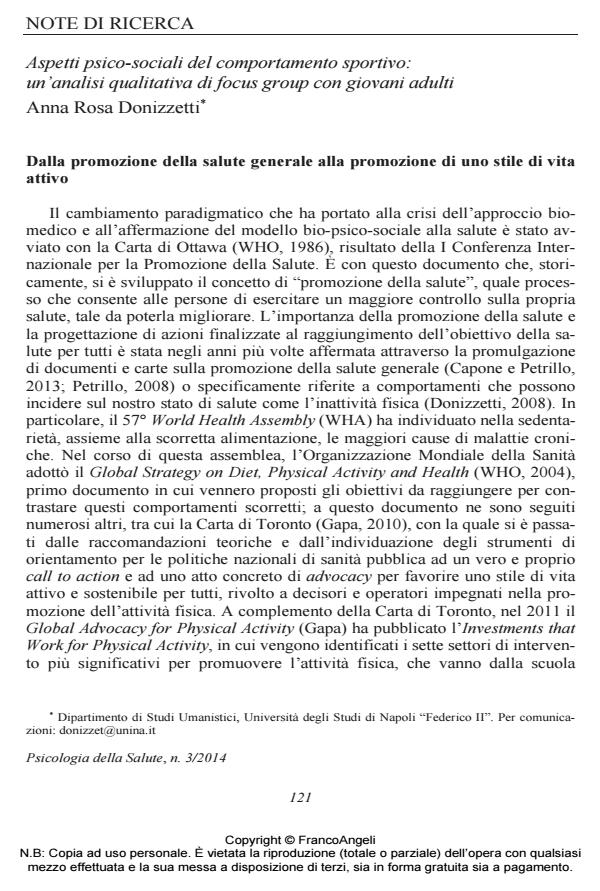Psycho-social aspects of sport behavior: a qualitative analysis of focus groups with young adults
Journal title PSICOLOGIA DELLA SALUTE
Author/s Anna Rosa Donizzetti
Publishing Year 2014 Issue 2014/3
Language Italian Pages 15 P. 121-135 File size 119 KB
DOI 10.3280/PDS2014-003007
DOI is like a bar code for intellectual property: to have more infomation
click here
Below, you can see the article first page
If you want to buy this article in PDF format, you can do it, following the instructions to buy download credits

FrancoAngeli is member of Publishers International Linking Association, Inc (PILA), a not-for-profit association which run the CrossRef service enabling links to and from online scholarly content.
It is widely recognized that the physical activity has important beneficial effects on the person not only from the biological point of view, but also psychological and social (Donizetti, 2008). In recent years the interest of the scientific community has been directed at understanding the psychological, social and environmental issues which can facilitate or impede the adhesion of the very young in sports, since the period of adolescence is one in which there is the stronger decline in participation. The role of these factors is, however, little studied in the later stages of development, and particularly among young adults. In light of these elements we set ourselves the goal is to analyze the factors that can affect sports participation of young adults, deepening the differences for sport (sedentary, active and sports). Were made in five focus groups attended by 33 college students (13 females and 20 males) aged between 21 and 34 years (M = 25.15, SD = 2.87). We used a guide for the conduct of focus groups were audio recorded and fully transcribed. For the analysis of the texts we have made use of the software T-Lab (Lancia, 2004). The corpus to be analyzed consists of 28.845 occurrences and 2.743 entries. Analyzes were conducted of the associations of words, the specificities and matches. The analysis showed that there are different physical activity minks related to different psychological aspects. For sedentary emerges a concept of physical self not supporting physical activity and a lack of or improper socialization to the sport. For assets you encounter the strong motivating factor for the maintenance or achievement of a body image in line with the fees charged by the company; and for athletes, sport is a coping strategy and a source of well-being. These initial results provide important insights for the development of interventions for the promotion of sports activities aimed at young adults who are, however, differentiated by level of sport.
Keywords: Physical activity, sport, young adults, bio-psycho-social aspects.
- The Relationship between Physical Activity and Psychosocial Well-Being during and after COVID-19 Lockdown Anna Rosa Donizzetti, in Behavioral Sciences /2023 pp.986
DOI: 10.3390/bs13120986
Anna Rosa Donizzetti, Aspetti psico-sociali del comportamento sportivo: un’analisi qualitativa di focus group con giovani adulti in "PSICOLOGIA DELLA SALUTE" 3/2014, pp 121-135, DOI: 10.3280/PDS2014-003007